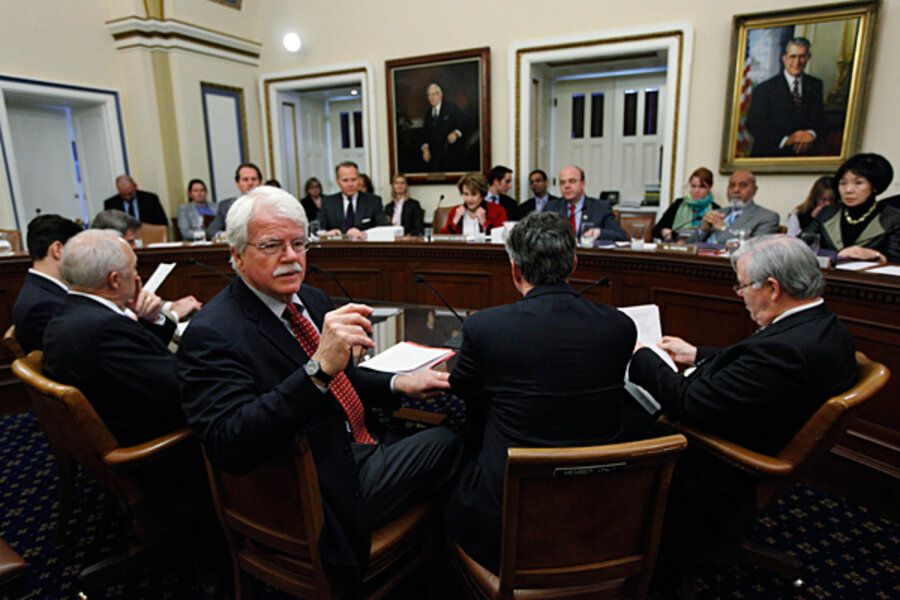Healthcare reform fallout: Which states are the winners?
Loading...
| New York
Under the nation’s healthcare reform plan, the nation’s Medicaid system will grow as one of the main organizations to implement the goal of expanded medical coverage.
But it appears that, from a financial standpoint, some states will be winners and some will be losers in this new arrangement.
Here's a look at why some states may stand to benefit. Later today, the Monitor will look at other states, which are complaining that it will cost their taxpayers a lot more money in the future.
The biggest winners, state officials and Medicaid experts say, could be those states that have already taken an important step toward expanding their own Medicaid programs: covering childless adults.
The reason for the coming windfall: These states are already paying for something that the new healthcare plan will soon mandate, and as the law's provisions begin to kick in, the federal government will actually pick up much of the burden that these states are now bearing.
The winners: 11 states plus D.C.
The 11 so-called "expansion states" states are: Arizona, Delaware, Hawaii, Maine, Massachusetts, Minnesota, New York, Pennsylvania, Vermont, Washington, and Wisconsin, plus the District of Columbia.
Currently, states that cover childless adults receive a 50 percent reimbursement for their costs. But the federal share of that reimbursement is set to increase, according to the bill of healthcare fixes, which tweak some of the numbers in the healthcare bill already passed and signed by President Obama.
(The fixes bill was passed by the Senate and the House Thursday and now goes to Mr. Obama to be signed into law.)
In 2014, the federal government will pick up 75 percent of the costs. By 2020, the fed’s share will grow to 93 percent.
By contrast, states that have not yet begun to cover childless adults will get federal reimbursements to cover 100 percent of their programs to start, but over time they will have to start paying for a portion of the cost. In other words, their expenses will eventually grow, while those of states that got a head start will gradually shrink.
Although it’s hard to quantify how much these states will save as a result of the changes, it will total in the billions of dollars annually.
Sitting pretty: New York, Maine
For example, since the year 2000, New York state has been providing Medicaid healthcare benefits for childless adults and parents at the federal poverty level ($10,800 for a single adult; $14,570 for two adults). As of February there were 388,000 people in that program.
Under the healthcare fixes – officially known as the reconciliation bill – the state would see a net gain of $2.1 billion, estimates Rep. Jerrold Nadler (D) of New York.
“The reconciliation bill does give financial benefits for the expansion states,” says Robin Rudowitz, Washington-based associate director of the Kaiser Commission on Medicaid and the Uninsured, part of the Kaiser Family Foundation.
Maine is another state that stands to benefit from the fixes bill. According to Rep. Mike Michaud (D) of Maine, the state, which already insures many childless adults under its Medicaid program, will receive an additional $154 million in federal financing from 2014 to 2019.
In other states, however, the exact value of the benefit – or whether there is a benefit at all – is in doubt because of the complexity of the issue.
Confident: Wisconsin
Wisconsin, for instance, has only a limited program to cover childless adults under Medicaid.
Buffeted by the economic downturn, the state wanted its Medicaid money to cover as many adults as possible since many had been laid off. But that meant offering each recipient less money than the federal government benchmark for reimbursement. Moreover, the state had so little money to put toward the program – and the need was so great – that the enrollment limit was filled within three months and there is now a waiting list.
With all these variables, how much will the new federal healthcare plan help? “We are in the process of working on the numbers but we are confident they will come out net to the good,” says Karen Timberlake, Secretary of the Department of Health Services in Madison.
Confusion: Arizona
Arizona demonstrates how fluid the numbers are. Four Arizona Democrats in Congress say their state will get $2.5 billion in new Medicaid funding under the new plan. But Gov. Jan Brewer, a Republican, estimates it will cost the state $1 billion in both 2012 and 2013.
The discrepancy has its roots in Arizona's decision to expand its Medicaid coverage to poor childless adults in 2000, adding an estimated 310,000 people to its rolls.
Faced with a large budget deficit in recent years, the state tried to cut its Medicaid coverage. But because it previously accepted federal stimulus funds – which included a Medicaid adjustment – it was not permitted to do so. The terms of the new legislation also make backing out difficult, if not impossible: The state cannot cut current services without risking lawsuits.
Governor Brewer's $1 billion estimate is based on the expansion of the program in 2012 and 2013. She calls the healthcare bill “financially devastating” to the state, which proportionately has one of the largest deficits in the nation.
The four Arizona Democrats in Congress, however, have called the governor’s estimates of the added Medicaid costs, “hyperbolic and completely unfounded.”
Healthcare reform fallout:
Part 1: Which states are the winners?





